Cognitive Behavioral Therapy (CBT) offers effective methods for improving mental health by addressing anxiety and depression. This article explores key techniques like cognitive restructuring, exposure therapy, and adaptations for children. It also examines cultural variations in CBT effectiveness and emerging trends such as technology integration and mindfulness. Additionally, we highlight common mistakes to avoid for optimal results in therapy.
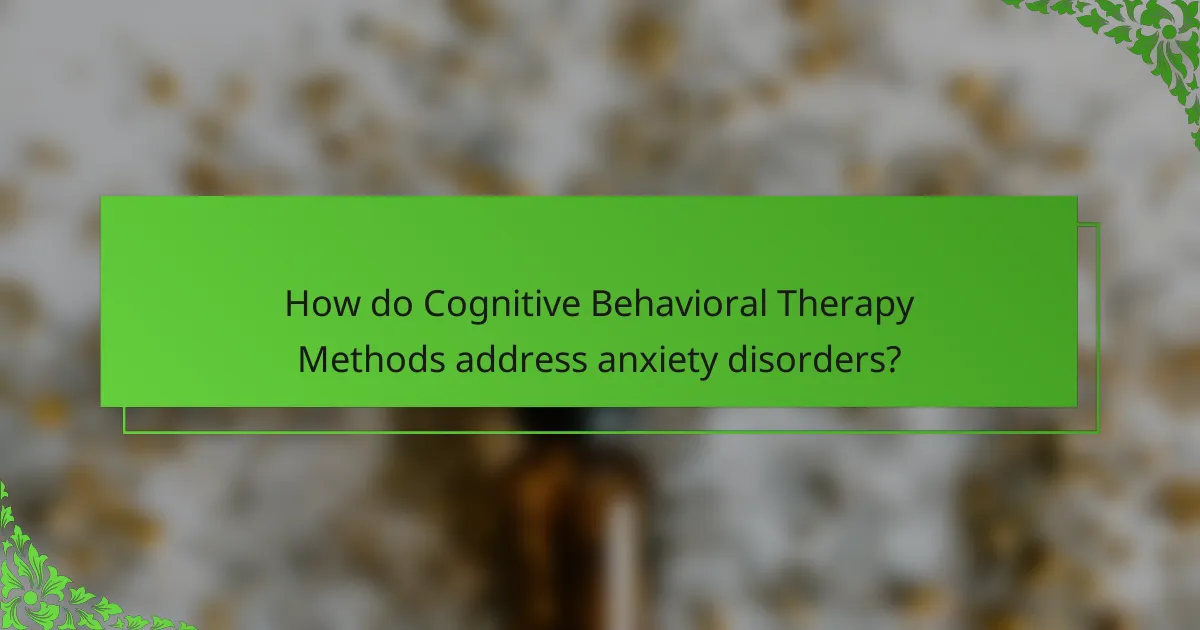
How do Cognitive Behavioral Therapy Methods address anxiety disorders?
Cognitive Behavioral Therapy (CBT) methods effectively address anxiety disorders by altering negative thought patterns. These methods include cognitive restructuring, exposure therapy, and behavioral activation, which help individuals confront fears and develop coping strategies. CBT has shown a 60-80% effectiveness rate in reducing anxiety symptoms, making it a widely endorsed treatment. Additionally, CBT promotes long-term skills that empower individuals to manage anxiety independently.
What specific techniques are used in CBT for anxiety?
Cognitive Behavioral Therapy (CBT) for anxiety utilizes techniques such as cognitive restructuring, exposure therapy, and mindfulness. These methods directly address negative thought patterns and behaviors that contribute to anxiety.
Cognitive restructuring helps individuals identify and challenge irrational beliefs. Exposure therapy gradually exposes patients to anxiety-provoking situations, reducing fear over time. Mindfulness encourages present-moment awareness, aiding in emotional regulation.
Research indicates that these techniques can significantly reduce anxiety symptoms, improving overall mental health outcomes.
Which populations benefit most from CBT for anxiety?
Individuals with generalized anxiety disorder, social anxiety disorder, and panic disorder benefit most from cognitive behavioral therapy. CBT effectively addresses thought patterns and behaviors that contribute to anxiety. Research shows that structured CBT can significantly reduce anxiety symptoms in these populations. Additionally, children and adolescents with anxiety disorders also experience positive outcomes from CBT, making it a versatile treatment option across age groups.
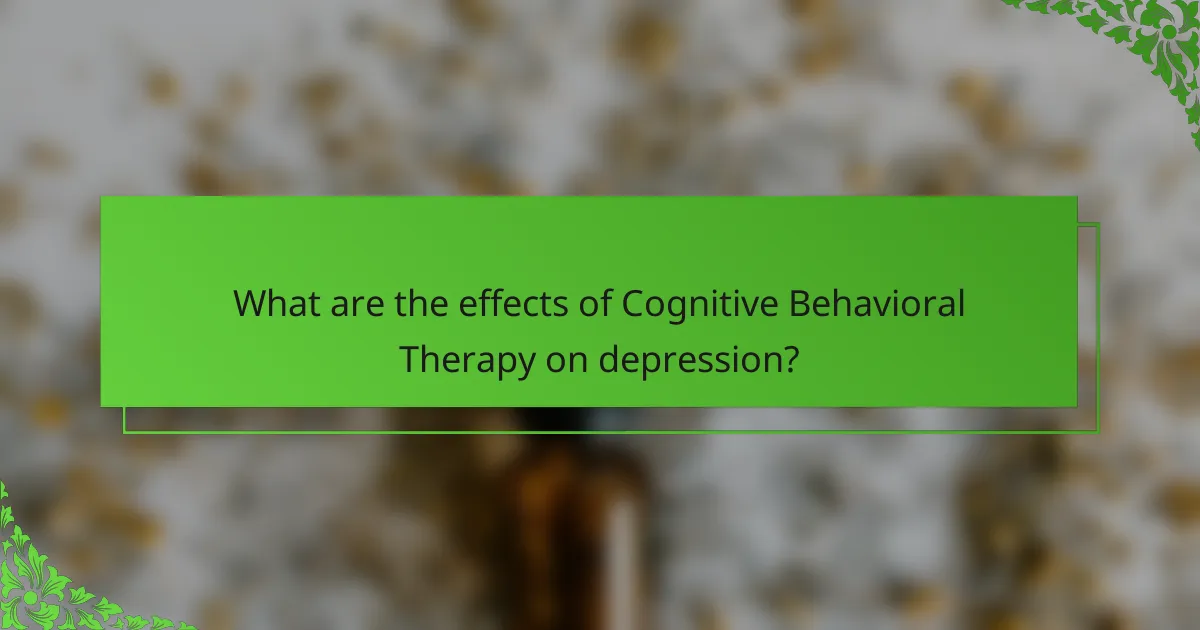
What are the effects of Cognitive Behavioral Therapy on depression?
Cognitive Behavioral Therapy (CBT) significantly reduces depression symptoms through structured interventions. CBT focuses on changing negative thought patterns, enhancing coping strategies, and promoting positive behavioral changes. Research indicates that approximately 60-80% of individuals experience symptom relief after completing a CBT program. This method empowers patients by teaching them practical skills to manage their depression effectively, often resulting in long-lasting improvements. Additionally, CBT can be tailored to individual needs, making it a versatile option for various depression types.
How does CBT compare to medication for treating depression?
Cognitive Behavioral Therapy (CBT) is often as effective as medication for treating depression, with fewer side effects. CBT focuses on changing negative thought patterns, while medication typically addresses chemical imbalances. Studies show that CBT can lead to long-term improvements in mental health, reducing the likelihood of relapse. Additionally, CBT equips individuals with coping strategies, promoting self-sufficiency in managing depression.
What are the long-term benefits of CBT for depression?
Cognitive Behavioral Therapy (CBT) provides long-term benefits for depression, including reduced symptoms and improved coping strategies. Patients often experience lasting changes in thought patterns, leading to enhanced emotional regulation. Research indicates that CBT can decrease relapse rates, allowing individuals to maintain progress over time. Additionally, skills learned during therapy can empower individuals to manage future challenges effectively.
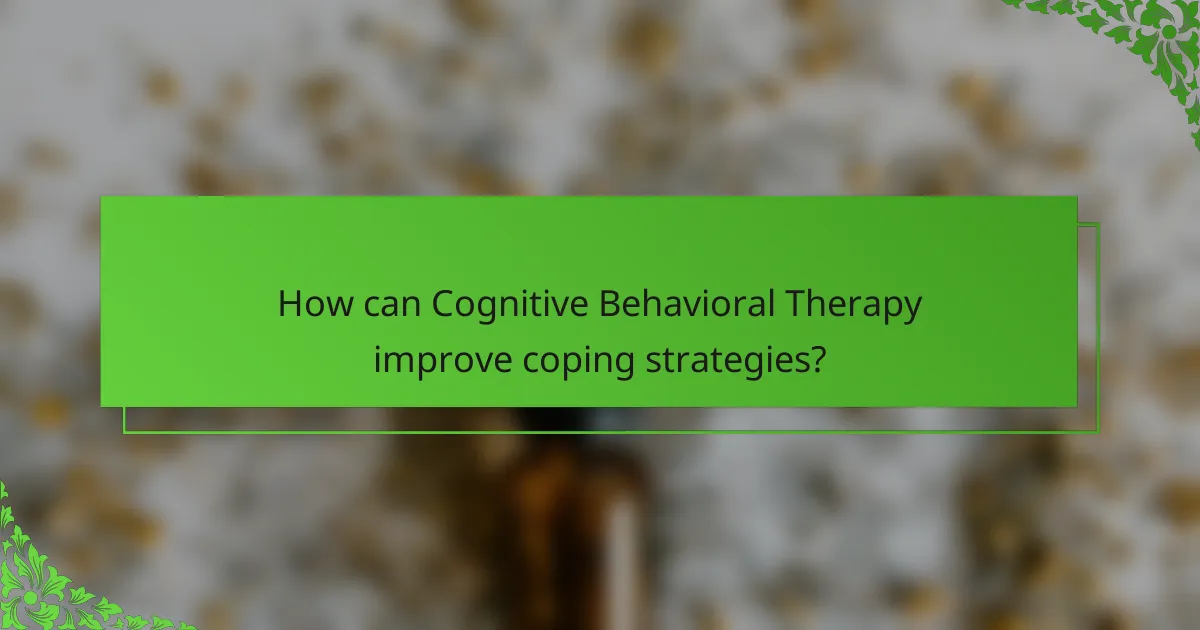
How can Cognitive Behavioral Therapy improve coping strategies?
Cognitive Behavioral Therapy (CBT) enhances coping strategies by teaching individuals to identify and challenge negative thought patterns. This method promotes healthier thinking, leading to improved emotional regulation and problem-solving skills. CBT techniques, such as cognitive restructuring and exposure therapy, empower individuals to manage stress and anxiety more effectively. As a result, clients often report increased resilience in facing life’s challenges.
What role does self-monitoring play in CBT?
Self-monitoring is crucial in Cognitive Behavioral Therapy (CBT) as it enhances self-awareness and accountability. It enables individuals to track thoughts, emotions, and behaviors, facilitating the identification of negative patterns. This process leads to more effective coping strategies and improved mental health outcomes. Research shows that individuals who engage in self-monitoring during CBT report higher treatment satisfaction and greater symptom relief.
Which cognitive distortions are commonly addressed in CBT?
Cognitive Behavioral Therapy commonly addresses several cognitive distortions, including all-or-nothing thinking, overgeneralization, mental filtering, disqualifying the positive, jumping to conclusions, magnification, emotional reasoning, and personalization. These distortions impact mental health by perpetuating negative thought patterns and contributing to anxiety and depression. By recognizing and challenging these distortions, individuals can improve their mental well-being and develop healthier thought processes.
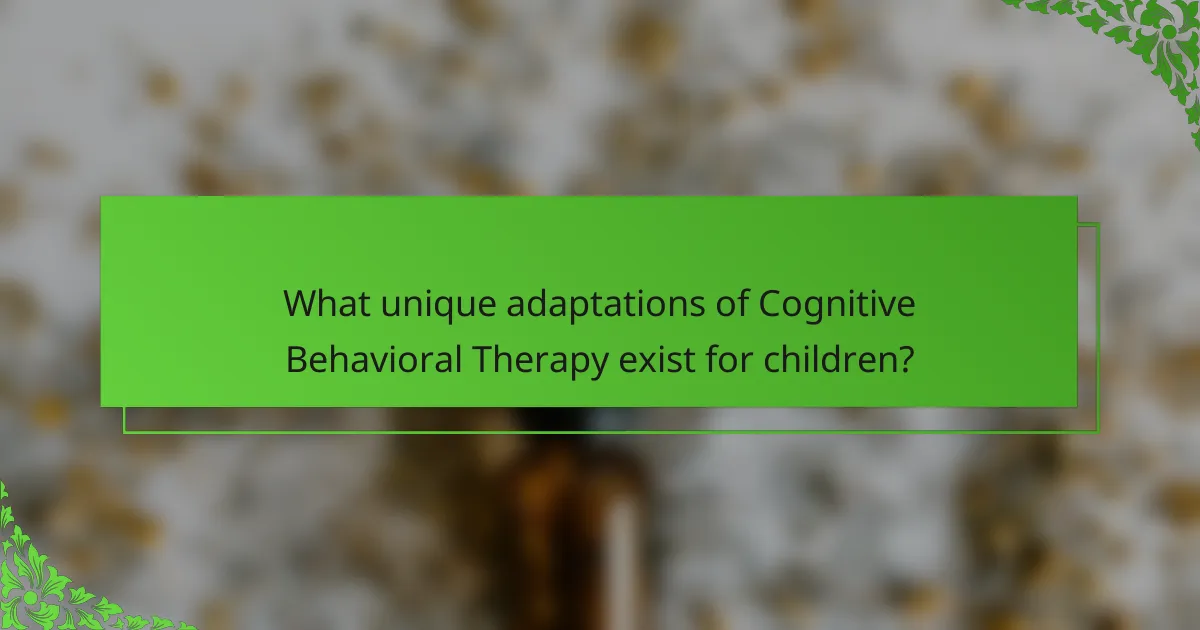
What unique adaptations of Cognitive Behavioral Therapy exist for children?
Cognitive Behavioral Therapy (CBT) for children includes unique adaptations that cater to their developmental needs. Techniques such as play therapy and art therapy integrate CBT principles, making the process engaging and relatable. These adaptations help children express emotions and thoughts effectively. Additionally, using visual aids and storytelling enhances understanding and retention of concepts. Tailored approaches ensure that therapy is age-appropriate, fostering a supportive environment that promotes mental health.
How does CBT for children differ from adult CBT?
CBT for children differs from adult CBT primarily in its approach and techniques. Children’s cognitive development and emotional understanding vary significantly from adults, necessitating adaptations in therapy.
Therapists often use play therapy and creative techniques to engage children effectively. This includes storytelling, art, and games, which help children express feelings and thoughts. In contrast, adult CBT focuses more on verbal communication and cognitive restructuring.
The duration and frequency of sessions may also differ. Children often require shorter, more frequent sessions to maintain engagement and focus. Adults typically engage in longer sessions with more emphasis on self-directed tasks.
Finally, parental involvement is crucial in children’s CBT. Parents often participate in sessions and are given strategies to support their child’s progress. Adult CBT usually emphasizes individual responsibility and self-management.
What are the key challenges in implementing CBT with children?
Implementing Cognitive Behavioral Therapy (CBT) with children poses several key challenges. These include communication barriers, as children may struggle to express their thoughts and feelings. Additionally, age-related cognitive development impacts their ability to understand and engage with CBT concepts. Another challenge is maintaining consistency in therapy sessions, as children’s schedules can be unpredictable. Lastly, parental involvement is crucial; without it, the effectiveness of CBT may diminish.

How does the effectiveness of Cognitive Behavioral Therapy vary across cultures?
The effectiveness of Cognitive Behavioral Therapy (CBT) varies across cultures due to differing beliefs about mental health. Cultural context influences how individuals perceive psychological issues and the acceptance of therapy methods.
In collectivist cultures, CBT may emphasize community and family dynamics, while individualistic cultures focus on personal autonomy. Studies show that cultural adaptations of CBT improve engagement and outcomes. For instance, integrating culturally relevant examples enhances relatability and effectiveness.
Moreover, language barriers can impact the therapeutic relationship, affecting the clarity of communication and emotional expression. Cultural stigma surrounding mental health may also deter individuals from seeking CBT, leading to variations in its effectiveness.
Overall, culturally sensitive adaptations of CBT can enhance its impact on mental health across diverse populations.
What cultural considerations should be taken into account when applying CBT?
Cultural considerations in applying Cognitive Behavioral Therapy (CBT) include understanding values, beliefs, and communication styles. These factors influence therapy effectiveness and client engagement.
Recognizing cultural stigma around mental health can affect openness to therapy. Adapting CBT techniques to align with cultural norms enhances acceptance and participation.
Incorporating culturally relevant examples and language fosters a stronger therapeutic alliance. Therapists should be aware of unique cultural practices that may impact treatment, such as family dynamics and traditional healing methods.
Ultimately, cultural competence in CBT leads to improved outcomes and client satisfaction.
How do different cultural backgrounds influence therapy outcomes?
Cultural backgrounds significantly influence therapy outcomes by shaping clients’ perceptions, communication styles, and coping mechanisms. Different cultural values can affect how individuals respond to Cognitive Behavioral Therapy (CBT) methods. For instance, collectivist cultures may prioritize family involvement in therapy, while individualist cultures may focus on personal autonomy.
Research indicates that culturally adapted CBT can enhance engagement and effectiveness. Clients from diverse backgrounds often feel more understood and valued when therapy incorporates their cultural context. This approach can lead to improved mental health outcomes and greater satisfaction with the therapeutic process.
Additionally, cultural stigma around mental health can impact therapy outcomes. In some cultures, mental health issues may be viewed negatively, leading to reluctance in seeking help. Addressing these cultural nuances is essential for therapists to foster trust and encourage open dialogue.
Ultimately, recognizing and respecting cultural differences can enhance the therapeutic alliance and improve the efficacy of CBT methods in diverse populations.

What are the emerging trends in Cognitive Behavioral Therapy practices?
Emerging trends in Cognitive Behavioral Therapy (CBT) include the integration of technology, personalized treatment plans, and a focus on mindfulness. Technology enhances accessibility through teletherapy and apps that support CBT practices. Personalized approaches consider individual differences, improving treatment effectiveness. Mindfulness techniques are increasingly incorporated to complement traditional CBT, promoting emotional regulation and resilience. These trends reflect a shift toward more adaptable and holistic mental health care.
How is technology shaping the future of CBT?
Technology is significantly enhancing Cognitive Behavioral Therapy (CBT) by improving accessibility and effectiveness. Digital platforms enable remote therapy sessions, making it easier for individuals to receive support. Additionally, mobile applications provide users with tools for tracking thoughts and behaviors, reinforcing CBT techniques in daily life. Virtual reality is emerging as a unique method, allowing patients to confront fears in a controlled environment. These advancements are reshaping how mental health care is delivered, making it more personalized and responsive to individual needs.
Which innovative CBT methods are gaining popularity in 2025?
Innovative Cognitive Behavioral Therapy (CBT) methods gaining popularity in 2025 include digital CBT, mindfulness-based CBT, and trauma-focused CBT. These approaches enhance traditional CBT by integrating technology and mindfulness practices to improve mental health outcomes.
Digital CBT utilizes apps and online platforms to provide therapy, making it more accessible. Mindfulness-based CBT incorporates mindfulness techniques to help individuals manage anxiety and depression effectively. Trauma-focused CBT addresses the specific needs of individuals with trauma histories, offering tailored interventions.
As a result, these methods are reshaping mental health treatment, making it more adaptable and personalized.
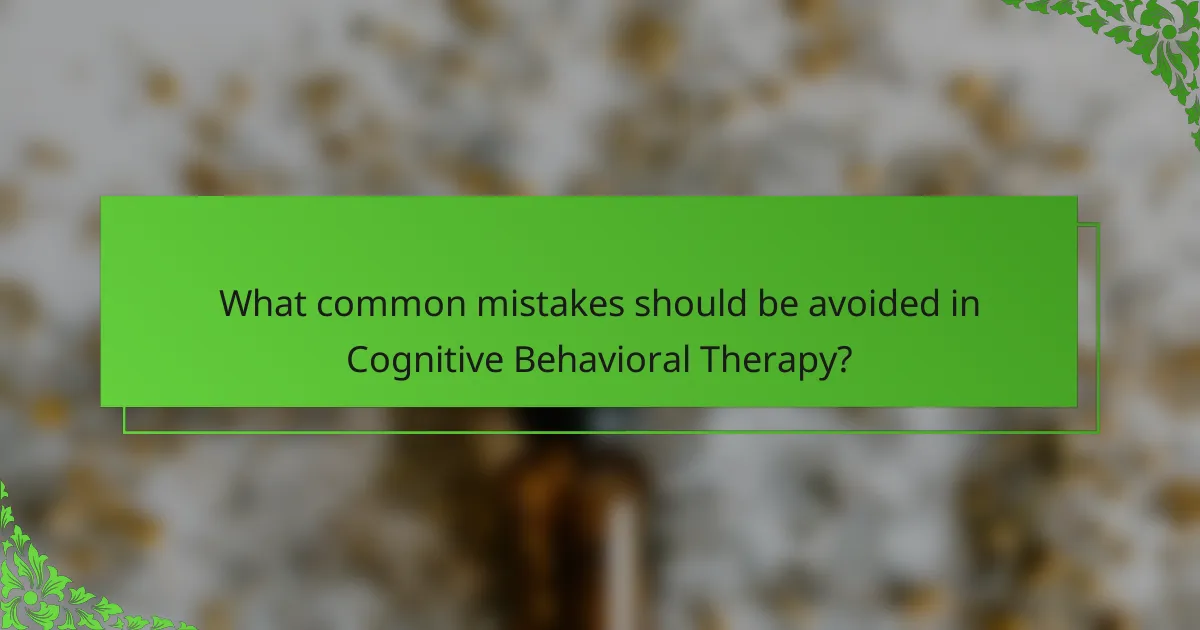
What common mistakes should be avoided in Cognitive Behavioral Therapy?
Avoiding common mistakes in Cognitive Behavioral Therapy (CBT) enhances its effectiveness. Key mistakes include neglecting homework assignments, misinterpreting cognitive distortions, and failing to establish a strong therapeutic alliance.
1. Neglecting homework assignments can hinder progress, as they reinforce skills learned in sessions.
2. Misinterpreting cognitive distortions may lead to incorrect conclusions, affecting treatment outcomes.
3. Failing to establish a strong therapeutic alliance can reduce trust, impacting client engagement and openness.
4. Overlooking individualized treatment plans may result in generic approaches that do not address specific client needs.
5. Ignoring the importance of tracking progress can prevent necessary adjustments to therapy techniques.
6. Avoiding confrontation of avoidance behaviors can stall the therapeutic process and limit effectiveness.
How can practitioners ensure they are delivering effective CBT?
Practitioners can ensure effective Cognitive Behavioral Therapy by adhering to structured techniques, continuous evaluation, and client engagement. Consistent application of evidence-based methods enhances therapeutic outcomes.
1. Establish clear goals with clients to guide therapy.
2. Regularly assess progress through standardized measures.
3. Adapt techniques based on individual client needs.
4. Foster a collaborative therapeutic relationship.
5. Incorporate feedback loops to refine approaches.
What are the signs of ineffective CBT interventions?
Signs of ineffective CBT interventions include lack of progress, increased anxiety, avoidance behaviors, and negative thought patterns persisting. Clients may also report dissatisfaction with therapy or feel disconnected from the process. These indicators suggest that the methods used may not align with the individual’s needs or therapeutic goals. Regular assessment of progress is essential to ensure the effectiveness of cognitive behavioral therapy.



